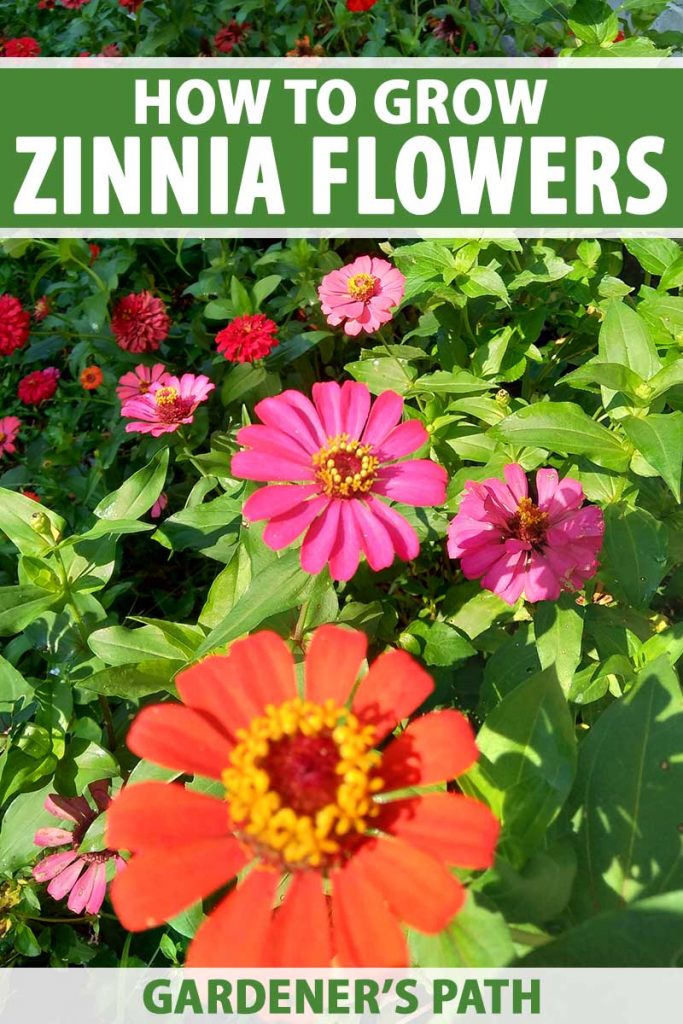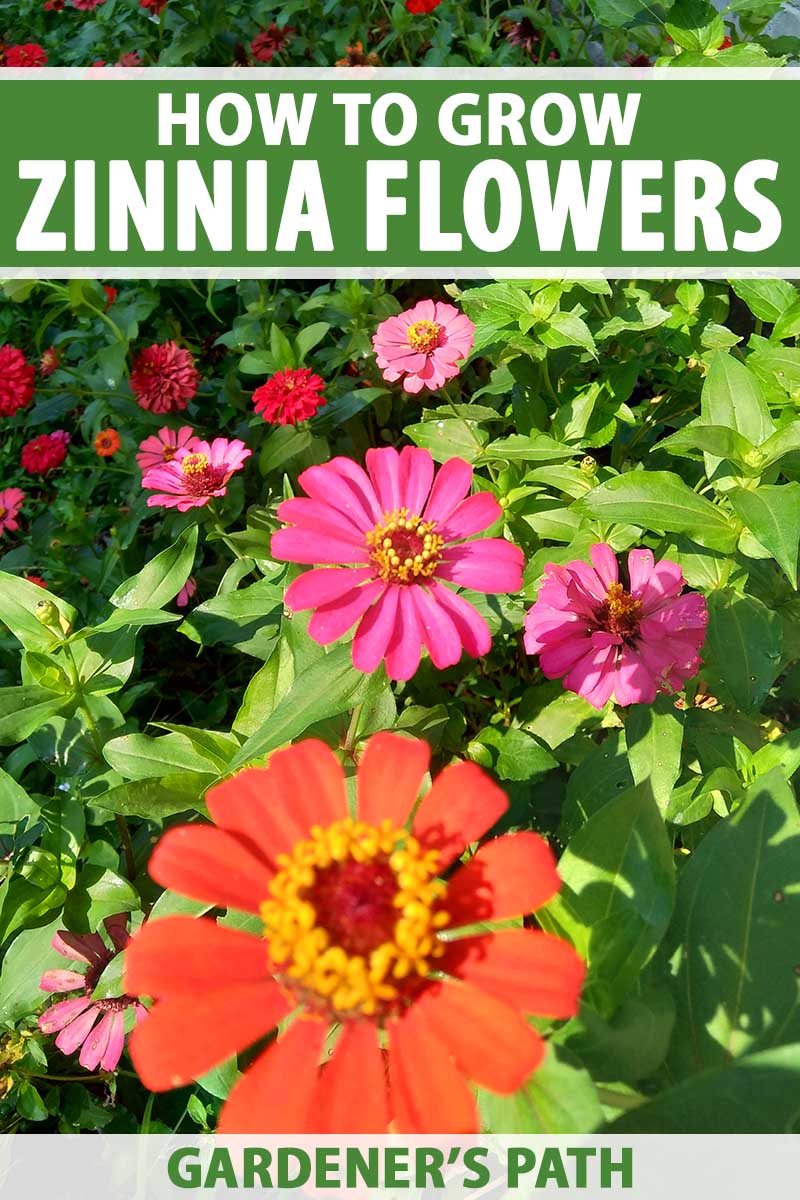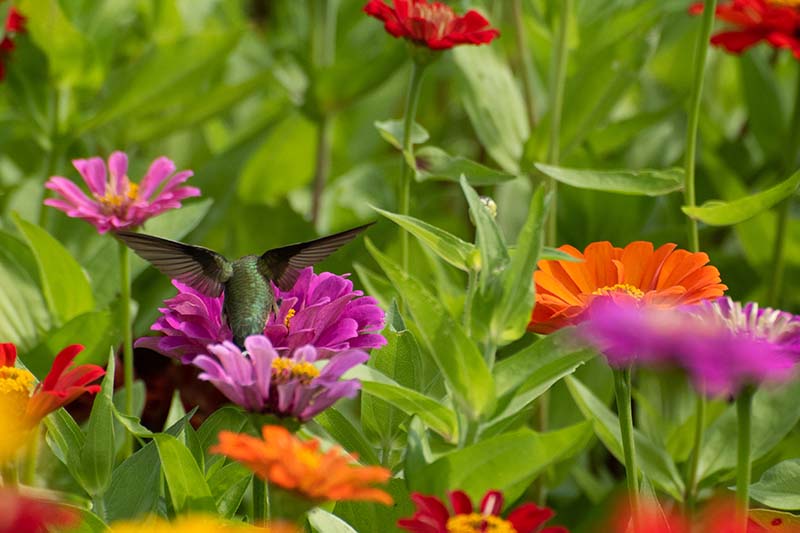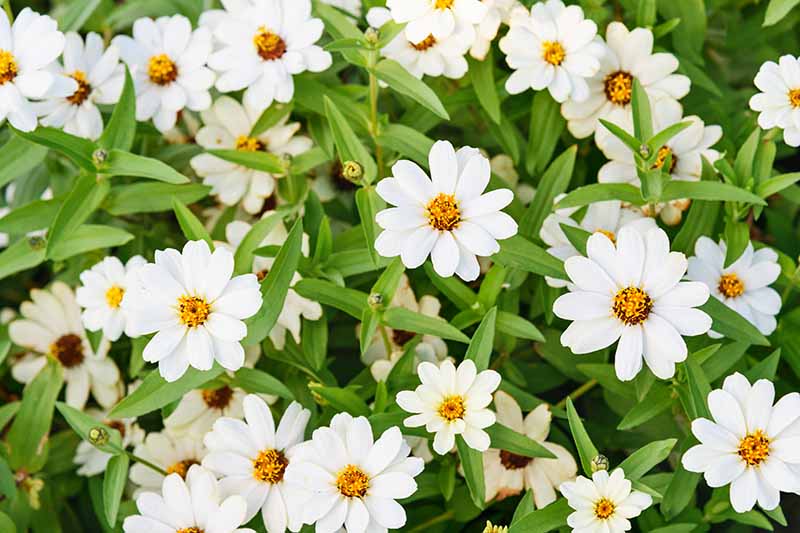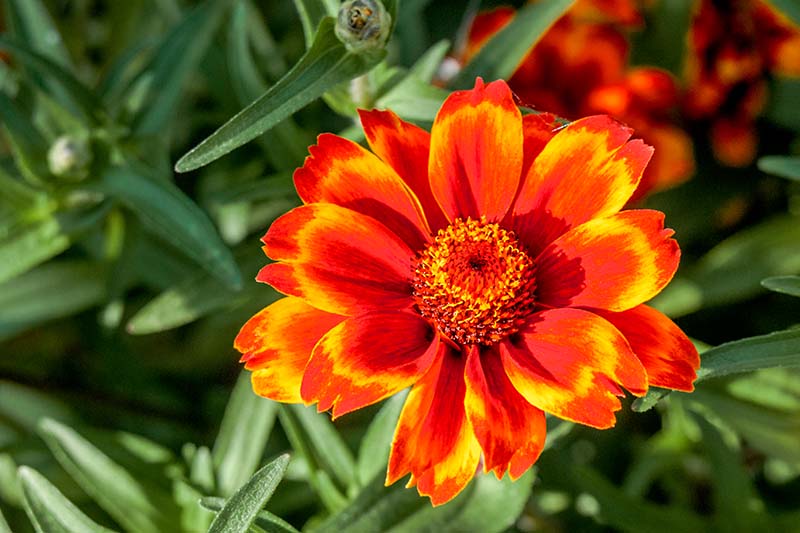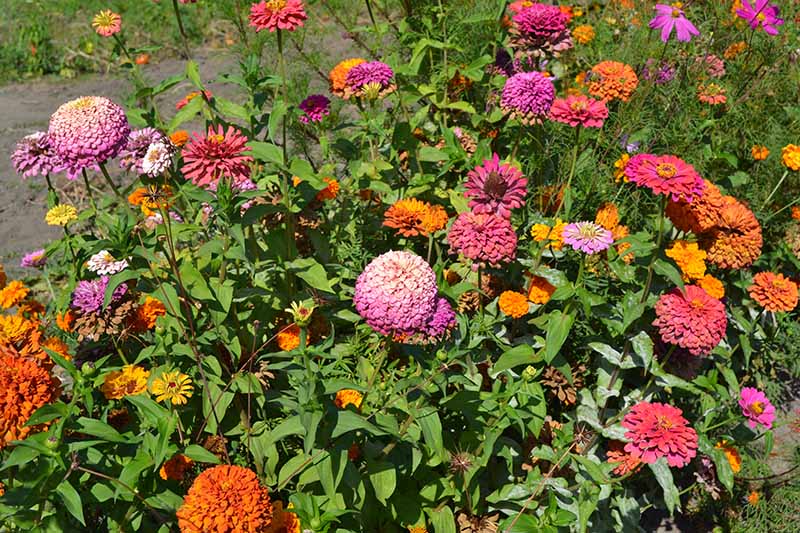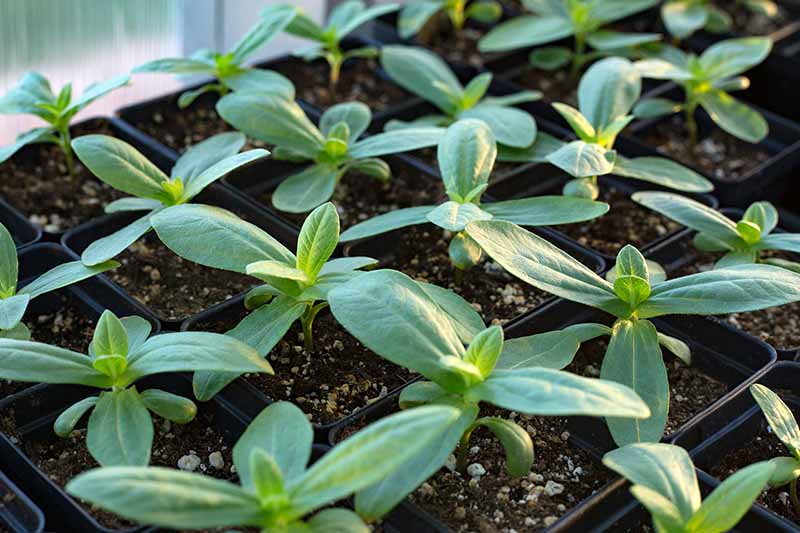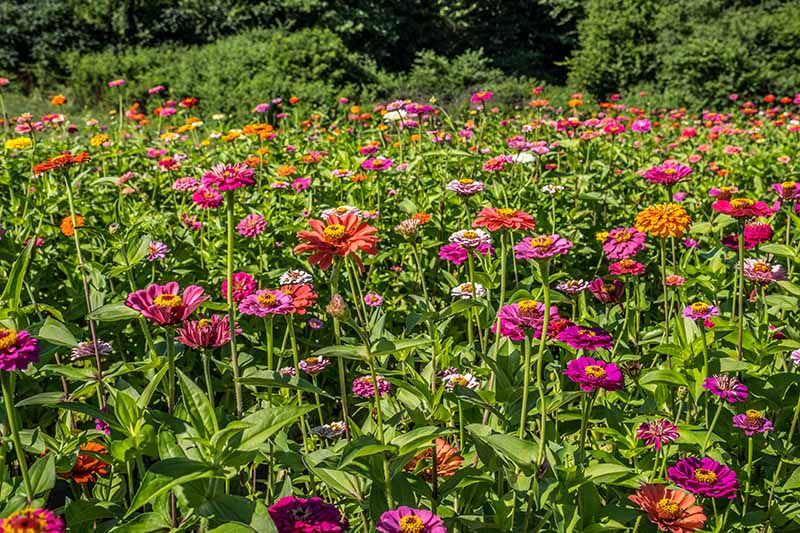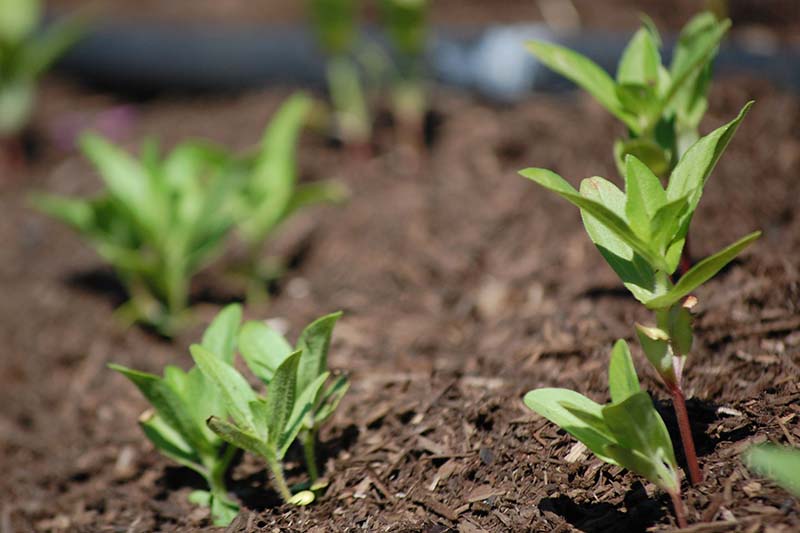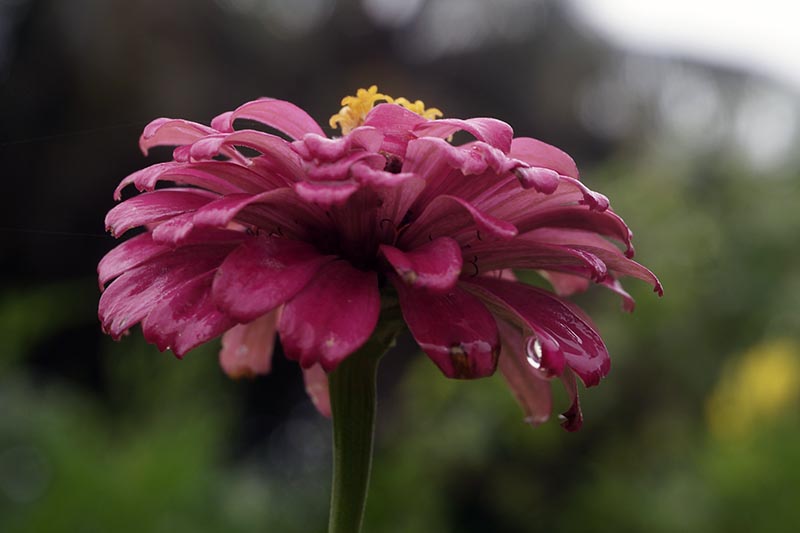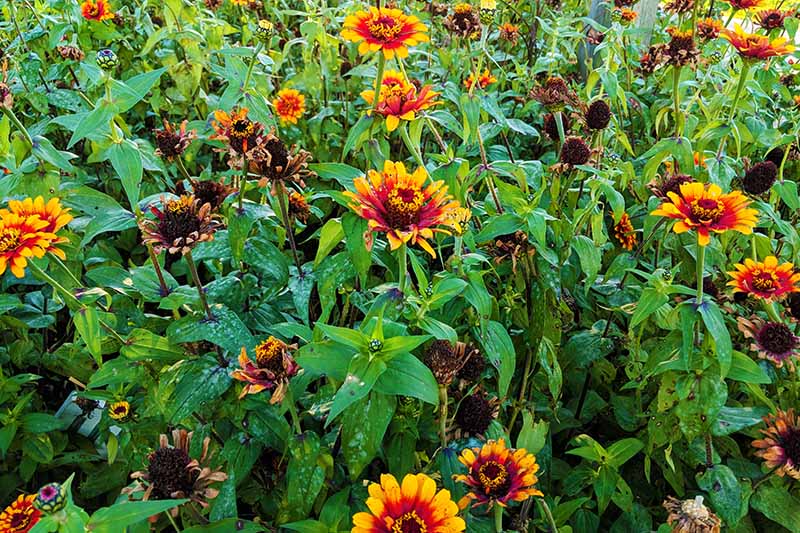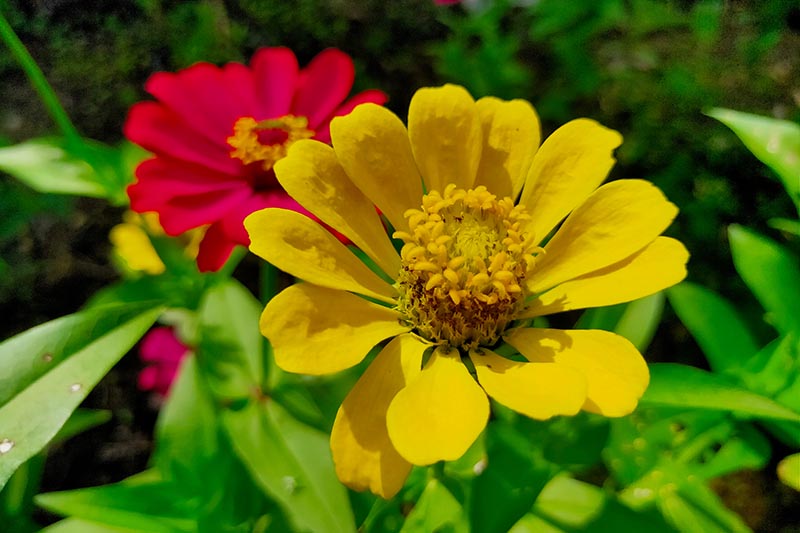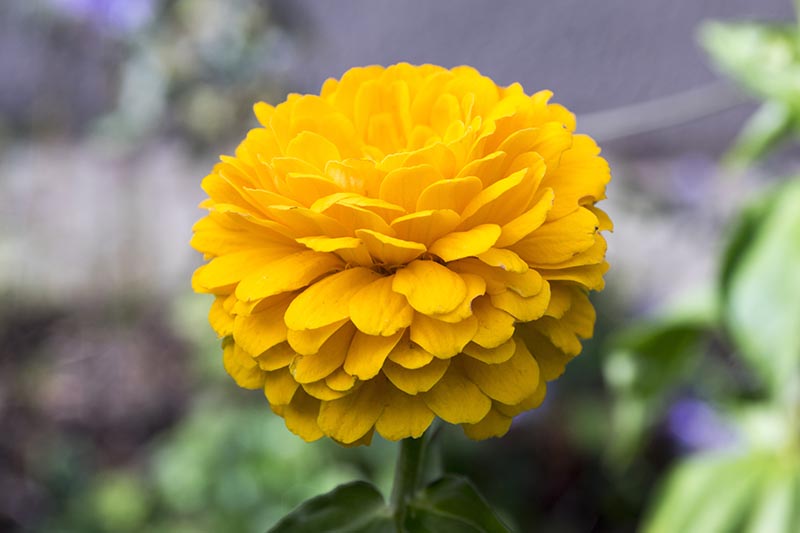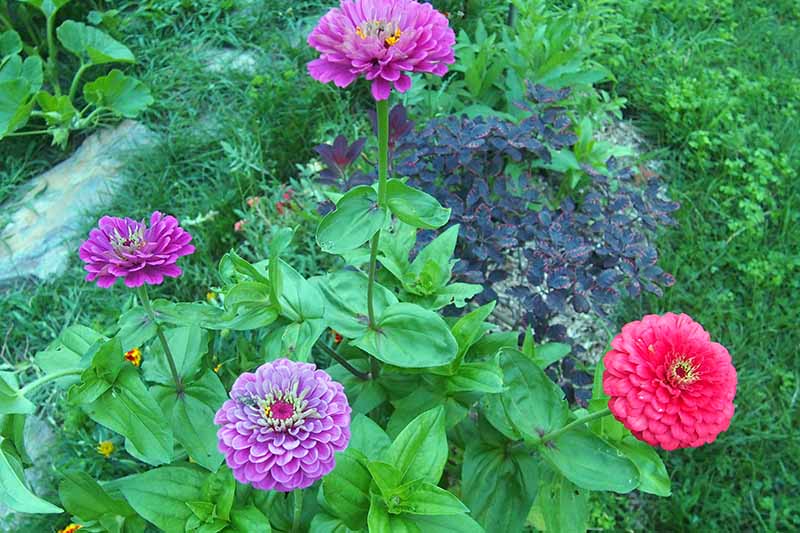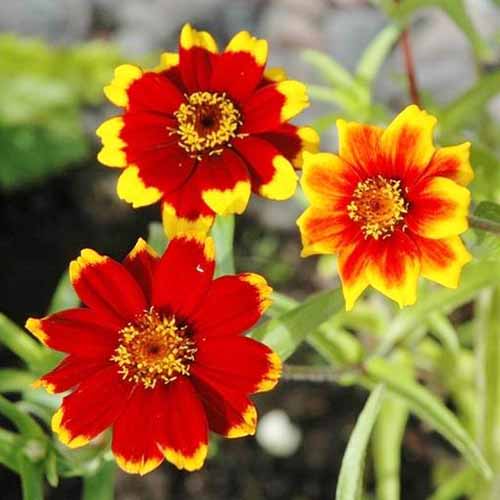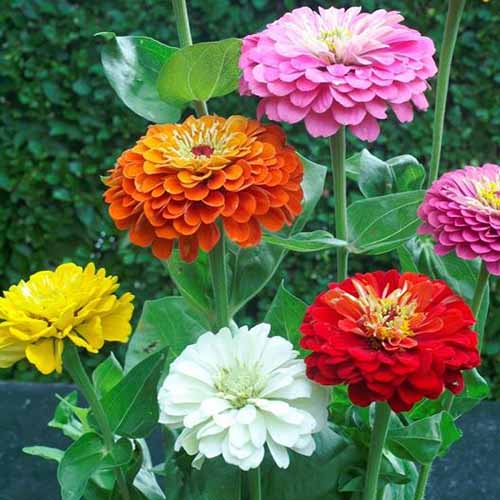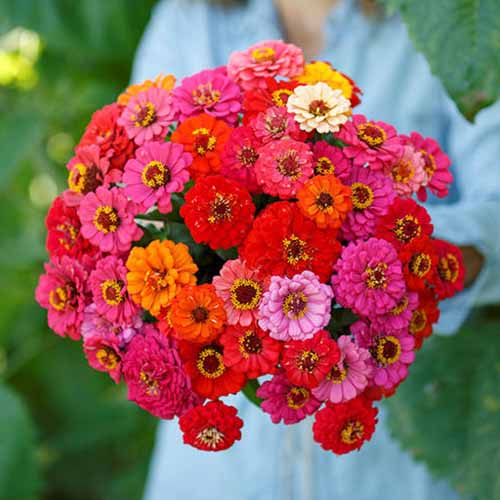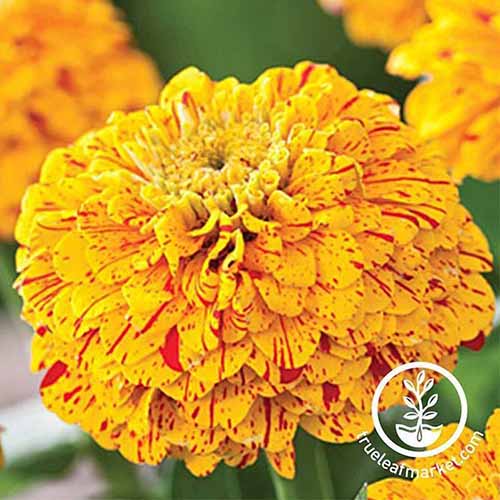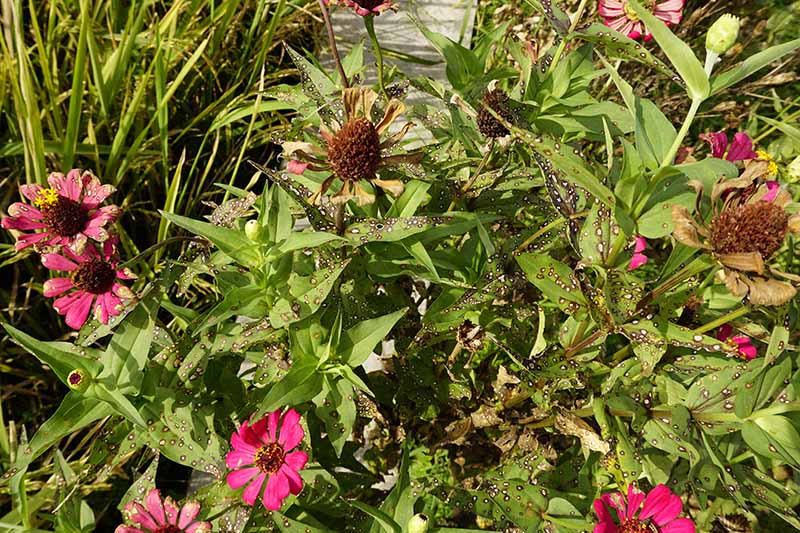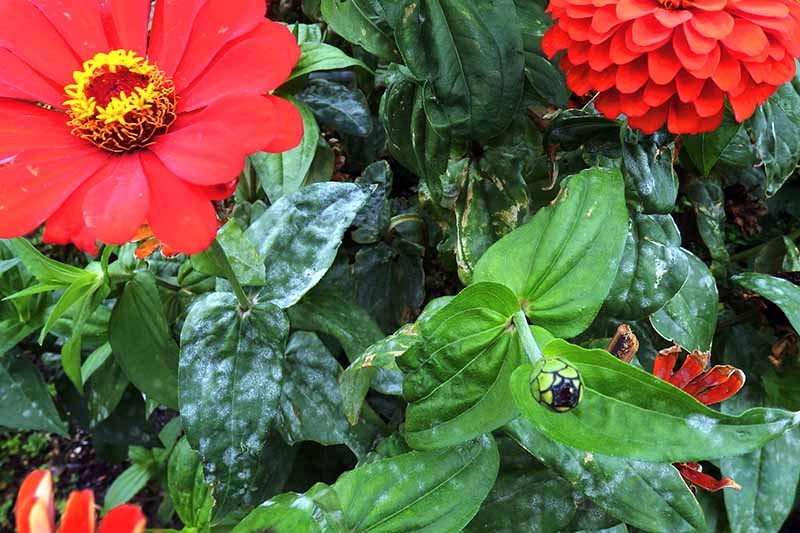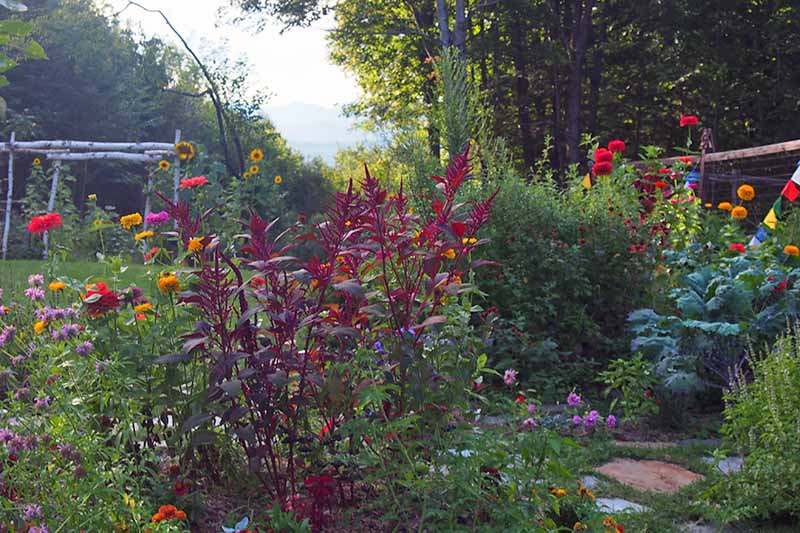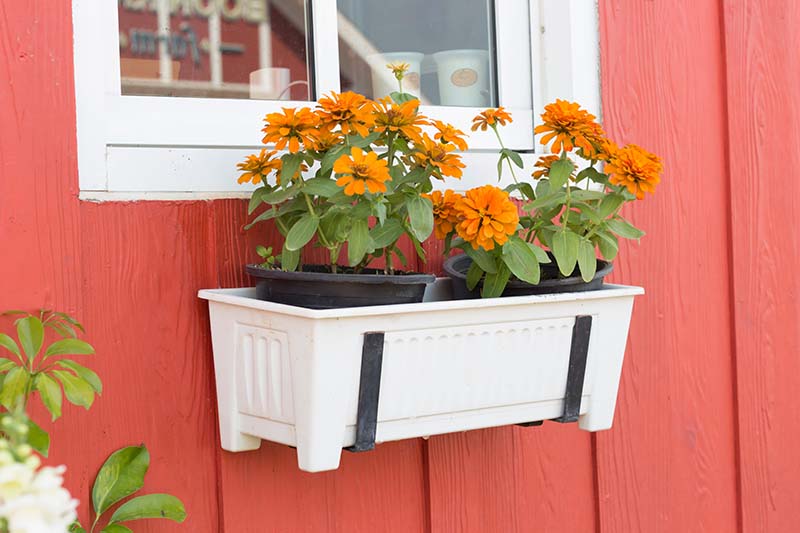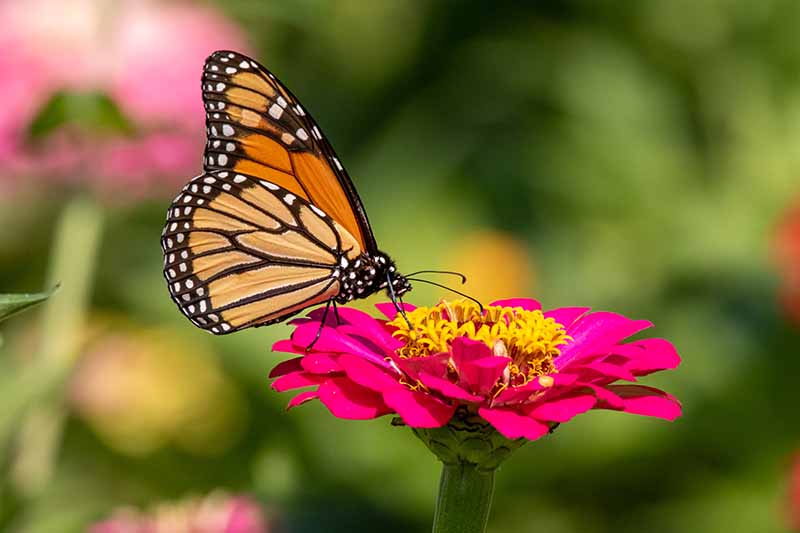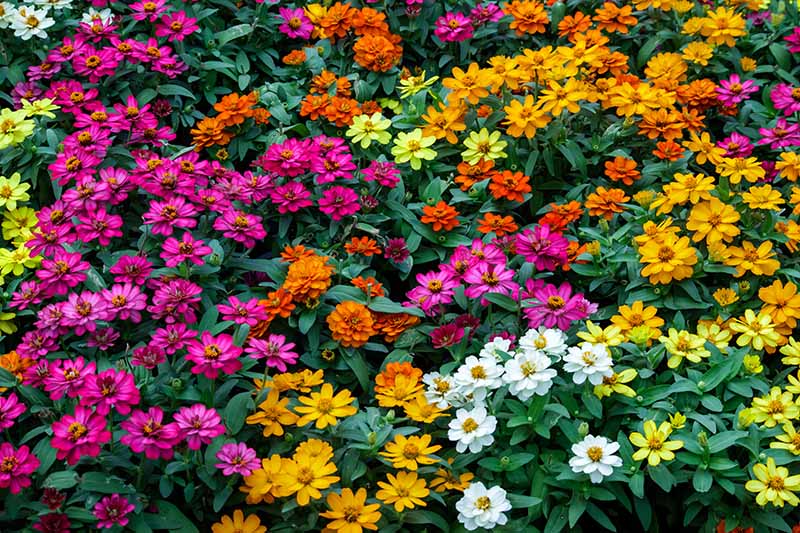What’s more, these show-stopping annuals are incredibly easy to grow. We link to vendors to help you find relevant products. If you buy from one of our links, we may earn a commission.
What Are Zinnias?
Zinnia is a genus of flowering annuals in the aster family, Asteraceae, that can be grown in USDA Hardiness Zones 3 through 10. They feature erect stems with bright solitary flower heads that produce large impressive blooms throughout the summer, attracting hummingbirds, butterflies, and other beneficial insects. While more than 20 known species exist in the wild, there are only a few species commonly available commercially, and these have been bred into hundreds of cultivars with flowers of many different forms. Plants can range in size from six inches to four feet tall, with single, double, or semi-double petaled flowers of many different shapes and colors. Z. elegans is the primary cultivated species. The wild plant has solitary flower heads of about two inches with black and yellow centers and purple petals. It is native to Mexico, but its original form is no longer easy to find due to cultivars that have escaped into the wild, which have interbred and naturalized in many places around the world. Z. angustifolia, also known as the narrow leafed zinnia, features smaller single flowers of white, yellow, and orange. Z. haageana, sometimes referred to as Mexican zinnia, has smaller single or double petaled flowers in yellows, orange, and red. Both of these species have been crossed with Z. elegans to produce many other varieties.
Cultivation and History
There are many myths floating around about the history of these flowers. It is likely that wild species were cultivated beginning in the 1500s by the Aztecs. One story goes that Gottfried Zinn, the German botanist that gave these plants their name in the 1700s, was accosted by bandits while collecting seeds in Mexico. However, according to Eric Grissell, author of “A History of Zinnias: Flower for the Ages,” this is unlikely to be true, as the supposed occurrence happened 150 years after his death. At any rate, these enticing flowers found their way from Mexico to Europe in the 1700s, were bred for all sorts of different traits, and eventually returned to the Americas, becoming popular in North American gardens in the early 1800s. With hundreds of cultivars available, these spectacular flowers continue to be one of the most popular garden annuals. They have even been grown in space! In January 2016, astronauts shared photographs of zinnias blooming aboard the International Space Station. The flowers were planted not only to beautify the station, but also provided opportunities for scientists to research how plants grow in microgravity.
Propagation
These flowers are easy to start directly from seed outdoors or can be propagated indoors to transplant out after the last frost. The roots are a bit sensitive to transplanting, so take extra care if you start seeds indoors.
From Seed
Sow seeds directly in the garden after the last frost, in a bed of well draining soil amended with compost. Seeds should be planted 1/4 inch deep a few inches apart in rows or clumps. Keep moist until germination, which usually only takes about a week. When seedlings are about three inches tall with a few true leaves, thin to six to 18 inches apart. Recommended spacing and mature spread varies depending on which cultivar you plant. Read the instructions on your seed packet for specific spacing requirements.
From Seedlings
Roots are sensitive and prefer not to be disturbed, so if you live somewhere with a long growing season, this annual is best started outdoors. In areas with shorter, cooler summers, transplanting can be a useful way to extend the season. It just needs to be done with care. It is useful to start seeds in two- to four-inch biodegradable containers like peat pots, or use seed blocks, to avoid disturbing the roots too much when transplanting them out. That being said, I start zinnias indoors every year, often using plastic containers, and mine have always done just fine. Start seeds about six weeks before the last frost, planting one-quarter inch deep in two- to four-inch pots filled with a well draining potting soil. Keep moist until germination occurs. Keep an eye on the seedlings as they grow, watering when the soil appears or feels dry to the touch, and try not to let plants become rootbound. Harden off for a week or so before planting out by moving seedlings outside for periods of increasing length each day, starting in a shady location and slowly moving to full sun. Zinnias are frost sensitive, so it is important to wait until after the last frost to plant them out in their permanent location. They prefer minimum daytime temperatures of about 60°F, with 74-84°F being ideal.
How to Grow
Grow in a full sun location, in garden soil amended with organic matter. Zinnias are adaptable to a variety of soil conditions, but prefer well draining soil with a pH between 5.5 and 7.5. Since they are prone to powdery mildew and other fungal conditions that thrive in areas with poor airflow, it is important to space your plants appropriately to provide good air circulation. Allow for between six and 18 inches between plants, depending on the variety. Check the back of the seed packet for specifics. Surround plants with at least two inches of straw or bark mulch to help with drainage, regulate soil temperature, and reduce weeds. Young plants need plenty of water, about an inch per week until they are well established. Water deeply a few times a week in the absence of rain so the soil stays moist. Mature zinnias are somewhat drought tolerant, and only need additional irrigation during periods of hot, dry weather. Water in the early morning to allow foliage to fully dry in the heat of the day. If possible, it is best to avoid overhead watering entirely, using a soaker hose instead to get water to penetrate deeper toward the roots while keeping the foliage dry. This will help reduce the risk of disease. While they don’t need a lot of feeding, you can mix a light application of a slow release, well balanced organic fertilizer into the soil prior to planting. You may also supplement with a monthly foliar feed to encourage bigger blooms. I recommend spraying foliage with compost tea or a well balanced organic fertilizer. You can learn more about making and using compost tea in this guide. Avoid high nitrogen fertilizers, which will increase foliage growth at the expense of flowering.
Growing Tips
Plant in full sun, in well draining soil amended with organic matter.Space adequately to encourage airflow.Apply mulch to improve drainage, regulate soil temperature, and reduce weeds.Water young plants deeply, providing an inch of water per week.Avoid overhead watering, and water in the early morning.
Maintenance
With proper care, zinnias can continue blooming for months! Deadheading spent blooms regularly will encourage new ones to form. When they are young, you can choose to pinch the growing tips to encourage side branching, resulting in shorter, bushier plants with more flowers. Keep in mind that this could delay flowering, especially in areas with short, cool summers. These frost sensitive annuals will die after the first hard frost. If you want to save seeds for the following season, allow the last few flowers to mature fully, then collect and store the seeds in a brown paper bag. You can learn more about how to collect flower seeds in our guide.
Cultivars to Select
The zinnia’s huge popularity in plant breeding over the last few centuries means there are many different cultivated varieties to choose from. With a seemingly endless list of options, I find it quite easy to get lost while browsing seed catalogs for zinnias! Flowers can take a few basic forms including single, double, and semi-double petal arrangements. Single flowers consist of a single row of petals with a visible center. Doubles have multiple rows with no visible center. Semi-doubles, my personal favorite, have multiple rows of petals with a visible center. Let’s take a look at a few of my favorite series and cultivars!
Managing Pests and Disease
While these flowers are easy to grow, issues with pests and disease do crop up from time to time. ‘Chippendale Daisy’ Seeds can be purchased from Eden Brothers in a variety of package sizes.
Crystal
An All-America Selections bedding plant winner in 1997 noted for being “highly tolerant of powdery mildew” and having an “excellent length of blooming season,” cultivars of Z. angustifolia from the Crystal™ series feature small, single-petaled daisy-like flowers that bloom all through the summer. Crystal Series The compact size of these eight- to ten-inch dwarfs makes them ideal for container growing either indoors or out. You can find packs of 500 seeds available from True Leaf Market in white, orange, or yellow.
Dahlia Flowered Mix
This is an heirloom cultivar of Z. elegans developed in 1919. Long 40-inch stems are topped with stunning double flowers that are four to five inches in diameter. ‘Dahlia Flowered’ The ‘Dahlia Flowered’ mix provides a stunning blend of pinks, yellows, and oranges. These bright and vivid blooms look beautiful in mass plantings, borders, and mixed garden beds. Seed packets of various sizes are available for purchase from Eden Brothers.
Dwarf Pepito Mix
If you are looking for something colorful to grow in containers, along borders, or in other small spaces, this semi-double dwarf variety of Z. elegans is a great choice. Dwarf ‘Pepito’ It matures to a conveniently manageable size, growing up to 10 inches tall, and produces a mix of pink, purple, red, yellow, and orange flowers with crimson centers. Dwarf ‘Pepito’ Mix seeds can be purchased from Eden Brothers.
Pop Art Golden and Red
This unique bicolor cultivar of Z. elegans is a new variety, granted Approved Novelty status by Fleuroselect for its large double-petaled golden flowers with red flecks, reminiscent of the comic-style work of Roy Lichtenstein and other pop artists. It grows 24 to 32 inches tall and spreads about a foot across. White and red or orange and red varieties of ‘Pop Art’ are also available. ‘Pop Art’ This variety is sensitive to cold, only able to withstand low temperatures down to around 60°F. Packs of 500 seeds can be purchased from True Leaf Market. Be sure to take a look at our supplemental guide: “15 of the Best Zinnia Varieties to Grow in the Garden.”
Just be sure to provide proper growing conditions and keep an occasional eye on your plants, and you shouldn’t have too much to worry about.
Insects
Zinnias are not significantly bothered by many insect pests, but damage can occur occasionally, especially when the weather is hot and dry.
Aphids
These small, often bright green insects can cause damage to foliage by sucking out the sap, leaving behind little holes. They can be found congregating in dense groupings on the undersides of leaves or along the stems. A strong stream of water sprayed on foliage from the hose can typically remove aphids. Spray leaves early in the day so they have a chance to dry out. Large infestations can be controlled with insecticidal soap or neem oil. Read more about dealing with aphids in the garden here.
Caterpillars
There are several types of caterpillars that may be found feeding on foliage, including the oblique-banded leafroller (Choristoneura rosaceana), beet armyworm (Spodoptera exigua), variegated cutworm (Peridroma saucia), and cabbage looper (Trichoplusia ni). In large numbers, caterpillars can defoliate the plant, destroying buds before they can bloom and stunting growth. Uncontrolled infestations may ultimately lead to plant death. The best way to remove caterpillars is by handpicking them and drowning them in a bucket of soapy water. You can also reduce the risk of infestation by weeding regularly. Providing ideal growing conditions will increase plant resiliency. As a last resort, Bacillus thuringiensis can be used to control caterpillars. It should be applied starting early in the season and requires repeated applications, because the caterpillars need to ingest the Bt for it to work.
Japanese Beetles
These pesky flying beetles (Popillia japonica) are about a half an inch in length with metallic blue-green heads and copper backs. They live in small groups, laying their eggs in the soil to overwinter underground. The adults emerge in summer to attack in groups, devouring foliage and flowers. Plants subject to severe infestation can be skeletonized, with only the veins remaining. Beetles can be hand picked and drowned in soapy water. An easy way to collect the beetles is by placing a drop cloth below the plant and shaking the foliage in the early morning when they are active. Applying neem oil can be an effective long term strategy. The beetles ingest chemicals in the oil and pass them on to their eggs, causing the larvae to die before reaching adulthood. Read more about dealing with Japanese beetles in the garden.
Spider Mites
Spider mites (Tetranychus urticae) are very small, and they appear in groups as tiny black dots. They can be found on stems and the undersides of foliage. Like aphids, they feed on sap, creating small holes in the leaves. And they can likewise be removed with a strong spray of water in the early morning. You can also pinch off affected foliage and destroy it to prevent further spread. Keep the area below plants free of debris, removing any fallen leaves and spent flowers. A serious infestation can be addressed by treating plants with insecticidal soap or neem oil. Since zinnias are such a good source of pollen and nectar for many beneficial insects, it is not recommended to use other chemical sprays. If using an insecticidal soap, spray late in the evening when beneficial insects are not out. Cover the entire plant, including the undersides of leaves.
Disease
There are a few pathogens and fungal diseases that can be a problem for zinnias, particularly in humid conditions with poor air circulation. For all of the following conditions, the best way to decrease the risk of disease is by reducing excessive moisture and providing adequate spacing. Always grow them in full sun in well draining soil, with plenty of space between each plant. It is also good practice to avoid overhead watering, using drip irrigation when possible. These diseases can spread from one plant to another via splashing water. Always remove and destroy affected plant parts when you see them. Keep an eye out for the following:
Alternaria Leaf Spot
This fungal disease, caused by the fungus Alternaria zinniae, produces small lesions that grow into dark concentric rings. It can cause foliage to become brittle and wilt.
Bacterial Leaf Spot
This bacterial pathogen (Xanthomonas spp.) appears as small and somewhat angular spots with a distinct yellow halo. Cankers can develop on stems and flowers become misshapen, ultimately leading to wilt and decay.
Cercospora Leaf Spot
Caused by the fungus Cercospora zinniae, this disease exhibits similar symptoms to alternaria, but with larger reddish brown or purple spots that mostly affect lower, older leaves, eventually causing them to drop from the plant. Sometimes both A. zinniae and C. zinniae may be present on the same leaf.
Powdery Mildew
This fungal disease, caused by Golovinomyces spadiceus, is particularly prevalent in humid areas. It causes a white film to form on leaves that can quickly overtake the whole plant. Foliage will eventually turn yellow and drop, leading to a reduction in flowering as well. In addition to reducing the risk of disease by providing good airflow and watering at the base of plants, powdery mildew can be treated with an application of neem oil. You can also try making a homemade organic spray by combining a tablespoon of baking soda with a tablespoon of horticultural oil in a gallon of water. Spray the foliage whenever you notice signs of disease.
Best Uses
Zinnias are perfect for anywhere in the garden that you want to draw attention to their eye-catching blooms. And their long flowering season means you will be dazzled with a show of vibrant colors all through the summer. They are wonderful additions to mixed planting flower beds and look beautiful when planted en masse. The more compact varieties make great border or container plants. Humans are not the only fans of these eye-catching flowers. Pollinators love the large, bright blossoms. Grow zinnias to attract beneficial insects, butterflies, and hummingbirds! They also make lovely cut or dried flowers. They can last for weeks in a bouquet, adding dazzling color to any space. To use for flower arrangements, cut the stems at an angle just above a bud node in the morning when flowers are opening. Strip off the leaves and set in a vase of warm water. You can easily dry the flowers by hanging them upside down in a bouquet in a well-ventilated area out of direct sunlight. Plant some zinnias this season, grab a lounge chair, and watch the hummingbirds and butterflies flock to them! What do you love most about growing zinnias? Share your stories and pictures in the comments section below! For more beautiful annual flowers to grow in your garden this year, check out these guides next:
Crazy, Colorful Celosia: A Growing GuideSnapdragon Is the Perfect Cutting Garden AnnualHow to Plant and Grow the Glorious Marigold
